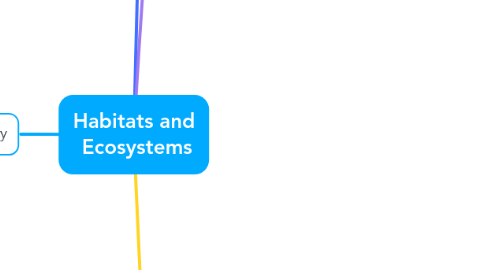
1. vocabulary
1.1. organism
1.1.1. ONE single living thing that can breathe and change
1.2. habitat
1.2.1. a place where an organism lives and gets EVERYTHING that it NEEDS to survive
1.3. ecosystem
1.3.1. a place where living things RELY on each other and their surroundings to survive
1.4. adaptation
1.4.1. something that helps an organism survive
1.5. predator
1.5.1. an animal that eats other animals - MEAT eater
1.6. prey
1.6.1. an animal that is EATEN by another animal/predator
1.7. omnivore
1.7.1. an animal that eats BOTH animals/meat AND plants
1.8. herbivore
1.8.1. an animal that eats ONLY plants
1.9. carnivore
1.9.1. an animal that eats ONLY meat/animals
1.10. impact
1.10.1. to make a big change
1.10.2. If one student makes a choice, others might follow that choice. The first student makes an impact on the other students.
1.11. negative
1.11.1. bad or takes away from something
2. habitat
2.1. can be considered smaller than an ecosystem
2.2. ADAPTATIONS
2.2.1. behaviorial and physical characteristics of an organism that help it to survive in its habitat
2.2.1.1. physical
2.2.1.1.1. CAMOUFLAGE
2.2.1.1.2. turtle - shell, protects from being eaten
2.2.1.1.3. camel - hump, collect and store water
2.2.1.1.4. lizard - sticky skin, helps climb up things
2.2.1.1.5. chameleon - camouflage, blends into environment
2.2.1.1.6. sea snake - camouflage, blends into environment
2.2.1.2. behavioral
2.2.1.2.1. megalodon (shark) - moves and acts calmly so that prey does not think it is a threat
2.2.1.2.2. cat - moves and acts calmly so that prey does not think it is a threat
2.2.1.2.3. fox - moves quietly and uses its fur (camouflage) to hide from both prey and predators
2.2.1.2.4. HIBERNATION
2.2.1.2.5. MIGRATION
2.3. NEEDS
2.3.1. food
2.3.1.1. plants - sunlight
2.3.2. air
2.3.2.1. oxygen
2.3.2.2. carbon dioxide
2.3.3. water
2.3.4. shelter
2.3.4.1. a safe place to grow
2.3.5. space
2.3.5.1. area to grow and change
2.3.5.2. plants need space for their roots
3. ecosystem
3.1. how all living things are connectetd
3.2. FOOD CHAINS
3.2.1. how energy moves through an ecosystem
3.2.2. the order in which plants and animals are eaten by each other
3.2.3. the sun starts most food chains since it gives plants energy
3.2.4. EXAMPLES
3.2.4.1. sun
3.2.4.1.1. leaf
3.2.4.1.2. flower
3.2.4.1.3. grass
3.2.4.1.4. plant
4. Changes in Habitats
4.1. Changes can be caused by nature OR by humans.
4.1.1. Natural Impacts
4.1.1.1. natural impacts -- something that happens in nature that is NOT caused by humans; it just happens because of nature
4.1.1.2. drought
4.1.1.2.1. when a habitat goes a long time without rain/water
4.1.1.2.2. Deserts are almost always in a drought.
4.1.1.2.3. If living things are not getting the water they need, then they might start to die out because they cannot survive.
4.1.1.3. flood
4.1.1.3.1. when a habitat gets TOO much rain/water at one time
4.1.1.3.2. lakes, ponds, rivers, and other water sources can overfill and flood the area around them
4.1.1.3.3. There is a type of flood called a flash flood. This is a flood that happens VERY QUICKLY without any warning.
4.1.1.4. forest fire
4.1.1.4.1. can also be called a wildfire
4.1.1.4.2. fire that starts due to lack of water and spreads wildly across an area
4.1.1.4.3. it will affect all the living things the most
4.1.1.4.4. can also be a HUMAN impact
4.1.1.5. natural disasters
4.1.1.5.1. hurricane - lots of fast wind and heavy rain; comes from the ocean
4.1.1.5.2. blizzard - lots of heavy snow, hard to see outside
4.1.1.5.3. tornado - lots of fast wind; comes from the land
4.1.1.5.4. earthquake - when the tectonic plates under the earth's surface, run into each other and cause vibrations
4.1.1.5.5. tsunami - when tectonic plates under the earth's suface run into each other UNDER THE OCEAN floor
4.1.2. Human Impacts
4.1.2.1. Negative Impacts by Humans
4.1.2.1.1. when humans cause something to be taken away from nature and its habitats
4.1.2.1.2. hunting
4.1.2.1.3. pollution
4.1.2.1.4. deforestation
4.1.2.2. Positive Impacts by Humans
4.1.2.2.1. Reduce- to use less of something
